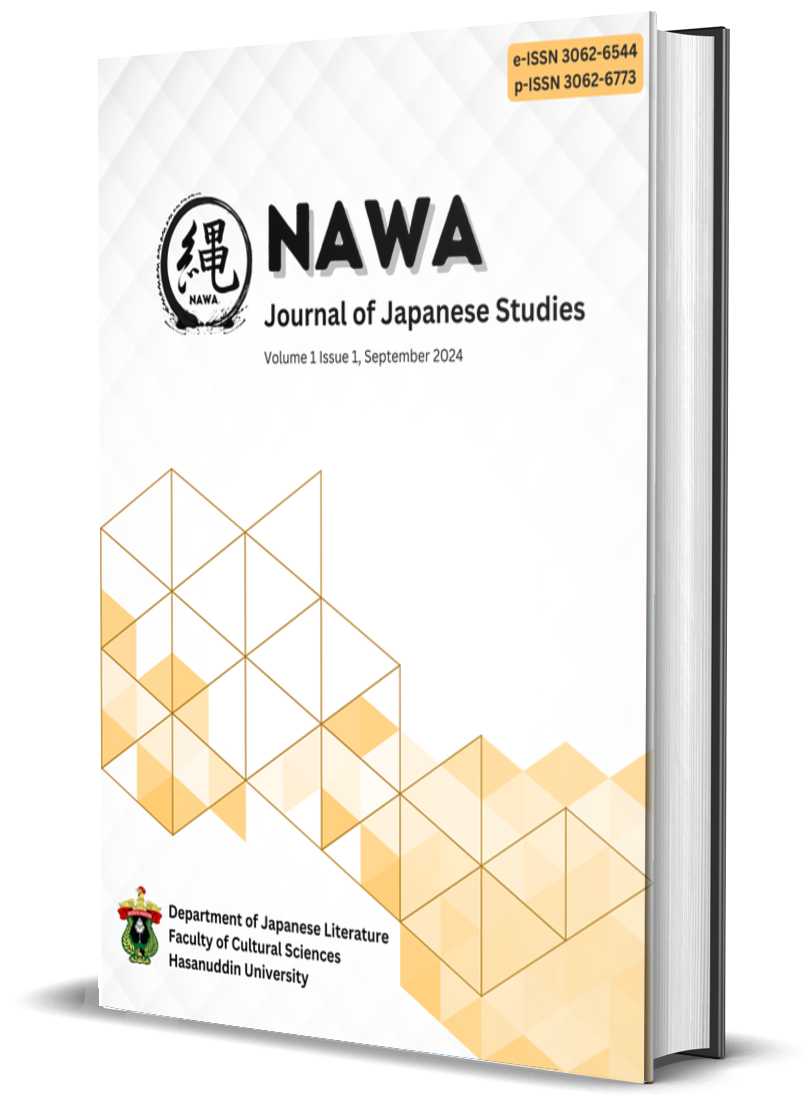Directive Speech Acts of "Command" on Death Note TV Series
DOI:
https://doi.org/10.69908/nawa.v1i1.34934Keywords:
speech act, directive, commands, pragmatic, Death Note TV seriesAbstract
This study aims to describe the types of speech acts of command contained in Death Note TV Series and classify the form of location in Death Note TV Series. This research is a qualitative descriptive research. The data of this research are Japanese command sentences in drama movies. The data source of this research is Death Note TV Series episodes 1 to episode 5. Data collection was done by listening and note-taking techniques. The data analysis technique used is data collection, grouping data based on classification, analyzing the data that has been grouped and concluding the research results. The results of this study there are two types of command speech acts, namely direct command speech acts and indirect command speech acts. In the direct speech act of commands, there are 16 data and indirect speech act of commands as much as 8 data.
Keywords: speech act; directive; commands
References
Alwi, H., et al. (2003). Tata Bahasa Baku Bahasa Indonesia. Jakarta: Pusat Bahasa dan Balai Pustaka.
Chaer, A., & Agustina, L. (2010). Sociolinguistics: An Initial Introduction. Jakarta: Rineka Cipta.
Dase, T. (2012). Tindak Tutur Meminta Maaf (Wabi Hyougen) dalam Drama Mother Karya Sakamoto Yuji. (Bachelor Thesis, Universitas Hasanuddin).
Isao, I., et al. (2000). Nihongo Bunpou Handbook. Japan: 3A Corporation.
Leech, G. (2015). Prinsip-Prinsip Pragmatik. Translated by M.D.D Oka. 1st ed. Jakarta: UI Press.
Mahsun. (2007). Metode Penelitian Bahasa: Tahapan Strategi, Metode, dan Tekniknya. Jakarta: Raja Grafindo Library.
Moleong, L.J. (2017). Metodelogi Penelitian Kuantitatif. Bandung: PT. Remaja Rosdakarya
Pratiwi, D. N. (2012). Penerapan Tindak Tutur Lokusi, Ilokusi, dan Perlokusi Ustad Nur Maulana pada Tayangan Islam Itu Indah di Trans TV. (Bachelor Thesis, Universitas Airlangga)
Rahardi, K. (2005). Pragmatik: Kesantunan Imperatif Bahasa Indonesia. Jakarta: Erlangga.
Rahmah, S. (2016). Tindak Tutur Ekspresif dalam Drama Sister. (Bachelor Thesis, Universitas Hasanuddin).
Rustono. (1999). Ilmu Pragmatik dalam Perspektif Kesopanan Berbahasa. Semarang: Semarang Press.
Sari, E. K. (2012). Realisasi Bentuk Tindak Tutur Direktif Menyuruh dan Menasihati Guru-Murid di Kalangan Andik TK di Kecamatan Sragen Wetan. (Thesis, Universitas Muhammadiyah Surakarta).
Setyanto, B. (2015). Tindak Tutur Ilokusi Dialog Film 5 CM Karya Rizal Mantovani (Sebuah Tinjauan Pragmatik). (Bachelor Thesis, Universitas Muhammadiyah Surakarta).
Sumarsono. (2002). Sociolinguistics. Yogyakarta: Student Library.
Wijana, I. D. P., & Rohmadi, M. (2006). Sosiolinguistik: Kajian Teori dan Analisis. Yogyakarta: Student Library.
Yule, G. (2006). Pragmatik. Translated by Indah Fajar Wahyuni and Rombe Mustajab. First printing. Yogyakarta: Student Library.
Downloads
Published
How to Cite
Issue
Section
License
Copyright (c) 2024 A M Nurfitrah I A, Nursidah Nursidah, Taqdir Taqdir

This work is licensed under a Creative Commons Attribution-ShareAlike 4.0 International License.







